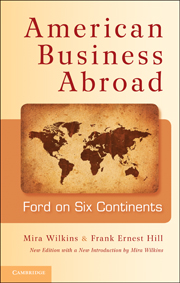Book contents
- Frontmatter
- Contents
- List of Illustrations
- Preface
- Introduction to the New Edition
- Introduction to the First Edition
- 1 First Venture
- 2 Probing for Markets
- 3 Model T: Triumph and Fable
- 4 The Alchemy of War
- 5 Steps in Expansion
- 6 The Sun Never Sets
- 7 Prosperity and Frustration
- 8 The Missionary Spirit
- 9 The Best-Laid Plans
- 10 Marriage of Convenience
- 11 Time of Desperation
- 12 A World Disturbed
- 13 Extreme of Nationalism
- 14 The British Empery
- 15 On Both Sides of World War II
- 16 The Crippled Phoenix
- 17 The New Company
- 18 Manufacturing for World Markets: From Dagenham to Geelong
- 19 New Times, New Faces, New Policies
- Appendices
- Bibliographical Essay
- Notes
- Index
- Titles in the series
- Plate section
8 - The Missionary Spirit
Published online by Cambridge University Press: 05 June 2012
- Frontmatter
- Contents
- List of Illustrations
- Preface
- Introduction to the New Edition
- Introduction to the First Edition
- 1 First Venture
- 2 Probing for Markets
- 3 Model T: Triumph and Fable
- 4 The Alchemy of War
- 5 Steps in Expansion
- 6 The Sun Never Sets
- 7 Prosperity and Frustration
- 8 The Missionary Spirit
- 9 The Best-Laid Plans
- 10 Marriage of Convenience
- 11 Time of Desperation
- 12 A World Disturbed
- 13 Extreme of Nationalism
- 14 The British Empery
- 15 On Both Sides of World War II
- 16 The Crippled Phoenix
- 17 The New Company
- 18 Manufacturing for World Markets: From Dagenham to Geelong
- 19 New Times, New Faces, New Policies
- Appendices
- Bibliographical Essay
- Notes
- Index
- Titles in the series
- Plate section
Summary
On February 17, 1923 Harvey Firestone of the Firestone Tire and Rubber Company invited Henry Ford to attend a conference in Washington “on the British Rubber Restriction Act which became effective November 1, 1922.” This act, popularly known as the Stevenson Rubber Scheme, had been designed to aid British planters of rubber in Ceylon and Malaya by restricting output and raising prices. Already, Firestone noted, rubber had risen 22 cents a pound in three-and-a-half months. “This means an increase of $150,000,000 in the crude rubber bill of the United States for 1923,” he pointed out. He wanted Ford, other American industrialists, and the American government to assist him in publicizing the improper features of the scheme, and to help devise means of combating it, perhaps by establishing rubber culture under American control.
In responding to this appeal, Ford undertook to further a crusade which might reduce the cost of one of his raw materials, but which he also considered a patriotic duty.
When Columbus on his second voyage to the mainland of South America landed at the mouth of the Amazon near what is now Belém, Brazil, he saw the natives throwing about a ball that bounced as if alive. This was the first encounter of white men with the product of Hevea brasiliensis, a native American tree which yields in its sap the purest raw material for the making of rubber.
- Type
- Chapter
- Information
- American Business AbroadFord on Six Continents, pp. 162 - 184Publisher: Cambridge University PressPrint publication year: 2011

